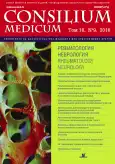Bilateral internal carotid artery occlusion: case report
- Authors: Gubskiy I.L1, Logunova T.A2, Nikogosova A.K1, Volkova N.N3, Osipovskaya I.A3, Cherepantsev G.R3, Bubman L.I3, Tyurin I.E2, Gubskiy L.V1
-
Affiliations:
- N.I.Pirogov Russian National Research Medical University of the Ministry of Health of the Russian Federation
- Russian Medical Academy of Postgraduate Education of the Ministry of Health of the Russian Federation
- Hospital for War Veterans №3 of the Department of Health of Moscow
- Issue: Vol 18, No 9 (2016)
- Pages: 17-20
- Section: Articles
- URL: https://journals.rcsi.science/2075-1753/article/view/94536
- ID: 94536
Cite item
Full Text
Abstract
Full Text
##article.viewOnOriginalSite##About the authors
I. L Gubskiy
N.I.Pirogov Russian National Research Medical University of the Ministry of Health of the Russian Federation
Email: shtangakun@gmail.com
аспирант НИИ цереброваскулярной патологии и инсульта ФГБОУ ВО РНИМУ им. Н.И.Пирогова 117997, Russian Federation, Moscow, ul. Ostrovitianova, d. 1
T. A Logunova
Russian Medical Academy of Postgraduate Education of the Ministry of Health of the Russian Federation
Email: logunova.tatiana@gmail.com
аспирант каф. лучевой диагностики, лучевой терапии и медицинской физики ФГБОУ ДПО РМАПО 125993, Russian Federation, Moscow, ul. Barrikadnaia, d. 2/1
A. K Nikogosova
N.I.Pirogov Russian National Research Medical University of the Ministry of Health of the Russian Federation
Email: gazanchyan.anait@gmail.com
аспирант НИИ цереброваскулярной патологии и инсульта ФГБОУ ВО РНИМУ им. Н.И.Пирогова 117997, Russian Federation, Moscow, ul. Ostrovitianova, d. 1
N. N Volkova
Hospital for War Veterans №3 of the Department of Health of Moscow
Email: Natnik2309@gmail.com
врач-рентгенолог ГБУЗ ГВВ №3 129336, Russian Federation, Moscow, ul. Startovaia, d. 4
I. A Osipovskaya
Hospital for War Veterans №3 of the Department of Health of Moscow
Email: IRO4444@mail.ru
врач-рентгенолог высшей категории, зав. отд-нием ГБУЗ ГВВ №3 129336, Russian Federation, Moscow, ul. Startovaia, d. 4
G. R Cherepantsev
Hospital for War Veterans №3 of the Department of Health of Moscow
Email: cherepautsev72@gmail.com
врач-невролог высшей категории, зав. отд-нием ГБУЗ ГВВ №3 129336, Russian Federation, Moscow, ul. Startovaia, d. 4
L. I Bubman
Hospital for War Veterans №3 of the Department of Health of Moscow
Email: bubmanleo@gmail.com
врач-хирург ГБУЗ ГВВ №3 129336, Russian Federation, Moscow, ul. Startovaia, d. 4
I. E Tyurin
Russian Medical Academy of Postgraduate Education of the Ministry of Health of the Russian Federation
Email: igortyurin@gmail.com
д-р мед. наук, проф. каф. лучевой диагностики, лучевой терапии и медицинской физики ФГБОУ ДПО РМАПО 125993, Russian Federation, Moscow, ul. Barrikadnaia, d. 2/1
L. V Gubskiy
N.I.Pirogov Russian National Research Medical University of the Ministry of Health of the Russian Federation
Email: gubskii@mail.ru
д-р мед. наук, доц. каф. фундаментальной и клинической неврологии и нейрохирургии МБФ ГБОУ ВПО РНИМУ им. Н.И.Пирогова 117997, Russian Federation, Moscow, ul. Ostrovitianova, d. 1
References
- Abu Rahma A.F, Copeland S.E. Bilateral internal carotid artery occlusion: natural history and surgical alternatives. Cardiovasc Surg 1998; 6 (6): 579-83.
- Mead G.E, Wardlaw J.M, Lewis S.C et al. No evidence that severity of stroke in internal carotid occlusion is related to collateral arteries. J Neurol Neurosurg Psychiatry 2006; 77 (6): 729-33.
- Persoon S, Klijn C.J, Algra A et al. Bilateral carotid artery occlusion with transient or moderately disabling ischaemic stroke: clinical features and long - term outcome. J Neurol 2009; 256 (10): 1728-35.
- Paraskevas K.I, Mikhailidis D.P, Liapis C.D. Internal carotid artery occlusion: association with atherosclerotic disease in other arterial beds and vascular risk factors. Angiology 2007; 58 (3): 329-35.
- Fujimura M, Tominaga T. Diagnosis of moyamoya disease: international standard and regional differences. Neurol Medico - Chirurgica 2015; 55 (3): 189-93.
- Anand P, Mann S.K, Fischbein N.J et al. Bilateral internal carotid artery occlusion associated with the antiphospholipid antibody syndrome. Case Reports Neurol 2014; 6 (1): 50-4.
- Sakata T, Kario K, Katayama Y et al. Studies on congenital protein C deficiency in Japanese: prevalence, genetic analysis, and relevance to the onset of arterial occlusive diseases. Semin Thromb Hemost 2000; 26 (1): 11-6.
- Abeloos L, Levivier M, Devriendt D et al. Internal carotid occlusion following gamma knife radiosurgery for cavernous sinus meningioma. Stereotact Funct Neurosurg 2007; 85 (6): 303-6.
- Cothren C.C, Moore E.E. Blunt cerebrovascular injuries. Clinics 2005; 60 (6): 489-96.
- Beckman J.A, Creager M.A, Libby P. Diabetes and atherosclerosis: epidemiology, pathophysiology, and management. JAMA 2002; 287 (19): 2570-81.
- Rabinstein A.A, Romano J.G, Forteza A.M et al. Rapidly progressive dementia due to bilateral internal carotid artery occlusion with infarction of the total length of the corpus callosum. Journal of neuroimaging: official J Am Soc Neuroimag 2004; 14 (2): 176-9.
- Amin O.S. Bilateral atherosclerotic internal carotid artery occlusion and recurrent ischaemic stroke. BMJ Case Rep 2015; 2015.
- Chandra R.V, Leslie-Mazwi T.M, Oh D et al. Extracranial internal carotid artery stenosis as a cause of cortical subarachnoid hemorrhage. AJNR Am J Neuroradiol 2011; 32 (3): E51-2; author reply E53.
- Caliskan E, Pekcevik Y, Polat B et al. Bilateral Internal Carotid Artery Occlusion as a Cause of Intraventricular Hemorrhage due to Pial Collateral Vessels. Turkish Neurosurg 2015; 25 (5): 808-10.
- Liebeskind D.S. Collateral circulation. Stroke; J Cerebral Circulation 2003; 34 (9): 2279-84.
- Лелюк В.Г., Лелюк С.Э. Ультразвуковая ангиология. Реальное время. М., 2003.
Supplementary files






